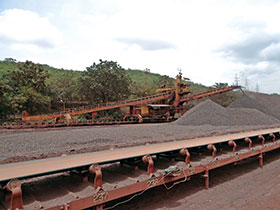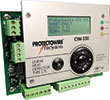

Due to the environment of underground mining and the limitations of transport options in these environments, mines rely heavily on the operation of their conveyor belt network for the day-to-day operation of their facility.
For this reason, the impact that a conveyor belt fire can have on the business continuity and profitability of a mine is huge. On many occasions a fire cannot only be harmful to the personnel working close to it, but the possibility of smoke inhalation to workers in other areas is a serious one.
If we take an example of a mine losing their main product feeder conveyor belt to fire, the loss of income due to the evacuation of the mine is damaging enough. However, the long term effect on business continuity due to the time taken for the belt to be repaired, the cost thereof and the peripheral damage caused by the fire, can be disastrous.
In some mining applications, such as coal mining, the transport of burning product can have a serious effect on the operations of a mine. Transportation and storage of burning coal can cause damage to property due to explosions or the spread of fire. There have been instances where the transportation and burning of coal storage facilities has caused fatalities.
For the above reasons, there are various options of conveyor belt detection products and methods available on the market. It is very important to determine firstly, whether the mine is wanting to protect the belt or whether they want to protect the product being transported on the belt.
The best protection solution
In terms of a coal mine and the ignition characteristics of coal, many mines will want to protect both the product as well as the belt itself. It is only important to protect the product on the conveyor belt should the possibility of ignition be high. When protecting the product, for example coal, we need to determine which form of detection will be the best for the application. As coal is a smouldering ember and not a large flaming fire, for this application we using ember detection. Ember detection has the ability to detect a glowing ember of 6 cm3 travelling at 6 m/s along a conveyor belt.
When protecting the belt, there are various methods of detection. The type of detection required is determined by budget, client requirements or a specific standard of detection. A conveyor belt has the large head and tail bearings, the rollers as well as the belt. All of these require detection and there are various options of detection.
The cheapest and most common form of detection is the use of Linear Heat Cable Detection (LHDC). LHDC can be placed at various points along the belt, it is often used to monitor the rollers along the bottom of the conveyor belt, these rollers often have bearing failure causing the roller to seize, when seized friction between the belt and roller increase and often cause the belt to ignite. Linear heat cable is also commonly run along the top of the belt and is used there to protect the belt from the top and detect fire from there.
Although LHDC technology has been around since the 1930s and is still commonly used, companies have developed new technology to prevent false alarms as well as make accurate point readings along the LHDC line. Protectowire have launched a CTI type cable which prevents false alarms by monitoring the circuit as well as using thermocouple technology to determine the increase of heat at the point to make sure that it is not a broken/damaged cable but an actual fire. Fibre optic LHDC has also been introduced which allow you to have longer runs of detection line with exact point monitoring.

Flame detection
Flame detection has also become a common method of detection for conveyor belts. When protecting both the belt or the head and tail of the belt, flame detection can be used. There are various flame detectors which all have various detection ranges depending on the length of the zone being detected. It is most common to use an IR3 type flame detector, this unit is UV blind as well as blind to arc welding which prevents false alarms and unnecessary downtime for the mine.
When monitoring the head and tail large spherical roller bearings in plumber blocks, it is good and common practice to use temperature probes. These monitor the bearing grease and bearing temperature. The available units provide two dual temperature monitoring with individual outputs which allow an early warning to be sent through prior to stopping the belt.
When deciding which unit and what peripherals in the systems are required for the conveyor belt there are a few factors which need to be taken in account. As mentioned above it is important to determine whether you are protecting the belt or the product being transported on the belt.
The environmental conditions also need to be taken into account, typically underground conveyor belts have increased humidity and dust. When designing a system using a flame or ember detector it is important to note that these units are optical devices. Taking that into account it is important to have air purging using a clean and dry air supply. There are various purge options available, these are extremely important when installing the system.
With the various options of control panels available and various protocols which allow for networking or integration in various systems, make the system health checks and functionality far easier. Typically a detector will have a standard fire and fault relay, this can be used to go back to the control panel. Often the control panel then provides an output to the mine PLC, this will allow the people in the control room to see when there is a fire or fault condition on the detector. There are various other options of monitoring, many detectors provide you with a 4 – 20 mA output which also allows you to monitor the health of the condition through a fire panel or directly into larger MCC units.
The fire alarm
There are various options of how to action a fire alarm when detected on a conveyor belt. On longer conveyor belts, the detections systems are zoned to smaller conveyor lengths, for example 20 m or 40 m this makes it easier to get to the fire. Often deluge systems are installed per zone, on detection of a fire, the belt in that specific zone is flooded to extinguish the fire.
When designing the deluge for a zone it is important to take the belt speed and shut down time into consideration (should there be a requirement to shut down the belt). For example if the belt is travelling at 5 m/s and it takes 3 seconds for the belt to come to a standstill, by the time the belt stops the risk will be 15 m further along the conveyor belt. Standard warning devices should always be activated when a fire condition is found on a conveyor belt. The typical sound rating should be above ambient sound levels and should include a visual warning for people who are hearing impaired or people working with hearing protection.
New innovations in fire detection for conveyors are based on preventing false alarms and avoiding unnecessary loss of productivity. The CTI LHDC which confirms the heat source at the point of the fire and fibre optic LHDC are newer technologies to prevent false alarms, increase detection distances of LHDC as well as prevent false alarms. This fibre optic solution is a solution for areas where there were previously many obstacles preventing an efficient and reliable fire detections solution.
For more information contact Technoswitch Fire Detection, +27 (0)11 794 9144, [email protected], www.technoswitch.co.za
| Tel: | +27 11 794 9144 |
| Email: | [email protected] |
| www: | www.technoswitch.co.za |
| Articles: | More information and articles about Technoswitch Fire Detection & Suppression |

© Technews Publishing (Pty) Ltd. | All Rights Reserved.